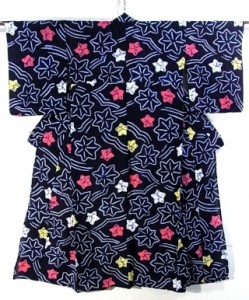 | Yukata
These are the most casual and probably the most comfortable to wear. They are made of cotton and generally have fun, vibrant, all-over prints. In Japan, very casual yukata are worn in ryokan (traditional hotels), onsens (public bath houses), and around the house. These typically are white with a simple indigo print, and are usually short enough not to drag on the floor. Yukata intended for festivals are often longer, and folded at the waist, and made of a more substantial cotton with brighter and more detailed prints. These types are a great place for beginners to get into the hobby, as they are fun, funky, and require the least amount of accessories – all you need is an undershirt, bike shorts, a few cotton ties, and a narrow obi. You can wear them to festivals, fireworks, picnics, barbeques, or any other fun summer activity. Imagine anywhere you’d wear jeans and a cute t-shirt or a casual cotton sundress. Appropriate obi to wear include hanhaba (hira) obi or heko obi. |
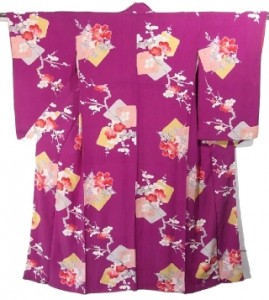 | Komon
Komon are the most casual level of “real” kimono. They are characterized by all-over patterns that can be either large or small in scale. They are typically quite informal, but can be made slightly more formal with small bits of metallic print or embroidery and in a pinch can be dressed up with a slightly nicer obi. However, they’re still the most casual of kimono. Appropriate situations for wear include lunch with friends, shopping in a high-end district, a trip to a museum. Similar to a nice pair of slacks or a day dress. Komon can be paired up with a variety of obi, including nicer hanhaba obi and nagoya obi. If the kimono is quite dressy or the obi is quite casual certain fukuro obi might work, but this is rare and safer to avoid if you’re unfamiliar or uncomfortable with the rules. |
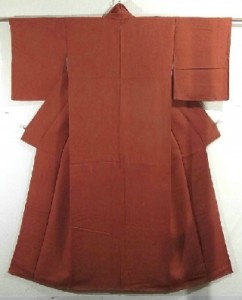 | Iromuji
By far the most versatile kimono in any woman’s wardrobe – think of iromuji as the “Little Black Dress” in your closet. With the right accessories they can go from running errands to a tea ceremony to the opera to the wedding of a friend. These kimono are one solid colour, but often made of very textural rinzu silk, which is woven in such a way as to have a tone-on-tone pattern. Patterns can include flowers, plants, textures, landscapes, really the possibilities are endless. Iromuji can also come with one, three, or five family crests – one crest is by far the most common. The more crests a kimono has, the more formal it becomes. A one-crested iromuji is probably the best investment you will ever make if you plan to wear kimono frequently. Due to the versatility of the kimono, many types of obi are appropriate, depending on the situation and formality. Anything from a dressy hanhaba obi, to nagoya, to fukuro are all acceptable. |
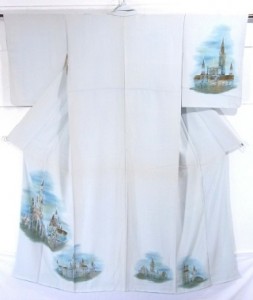 | Tsukesage
Tsukesage are generally a solid colour with designs in a few very specific locations – along the hem, the front panel, the sleeve, the shoulder, and the collar. They can be quite vibrant or relatively subdued, and work in a variety of situations. Dinners out, trips to the theatre. They’re good for when you want to dress up a bit and stand out, but not very formal events. Tsukesage do not come with crests, so they are not particularly appropriate for ceremonial events. Suitable obi are nagoya, and fukuro if the kimono has enough dressy elements. |
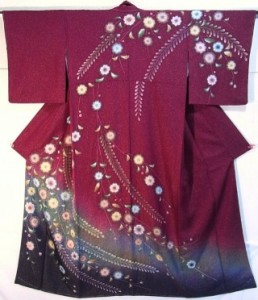 | Houmongi
Similar to tsukesage, but slightly more formal. Rather than having separate design elements on each panel, there is a continuous design across the entire hem and generally across the shoulders. They can also have one crest on the back, which further helps to make them a bit dressier. Houmongi are often worn to weddings, especially fancier ones in large reception halls or hotels. To me, the houmongi is the “quintessential kimono”, the kind most people picture a woman in a lovely kimono, or the kind often bought to hang on walls as art. The best obi for houmongi is usually fukuro or fukuro-nagoya, but maru obi and certain nagoya can work well too. |
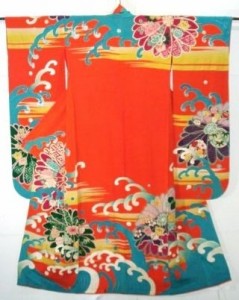 | Furisode
Furisode actually refers to sleeve length, rather than the pattern layout. “Sode” means sleeve and “furi” means swinging. Furisode have very long, swinging sleeves. They are generally worn by young, unmarried women. Furisode can come in different pattern layouts; komon, houmongi-style, and even iromuji style. They also come in several sleeve lengths; ko-furisode – which are the shortest and can be worn almost like regular kimono, chuu-furisode (also listed as chuburisode) – which are slightly longer and generally a bit more formal, and ooburisode – the longest and generally the most formal. Kimono worn for coming-of-age day, weddings, etc, have ooburisode sleeves. Furisode also typically require fancy obi musubi (obi knots) to balance the volume and style of the sleeves, so the only proper obi to be worn with them in normal settings are fukuro or maru obi. |
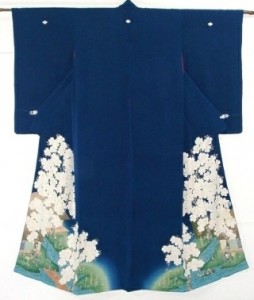 | Irotomesode
Iro means colour, and tome-sode means short sleeves, so logically iro-tomesode would be a coloured, short-sleeved kimono. Design-wise, they have a fairly ornate continuous pattern around the hem, and nothing above the waist. They are often crested, anywhere from one to five crests, and are worn by both married and unmarried women for formal or ceremonial events. They’re not as common as they used to be, and the ones that end up on the market most often are vintage. Acceptable obi would be fukuro or maru. |
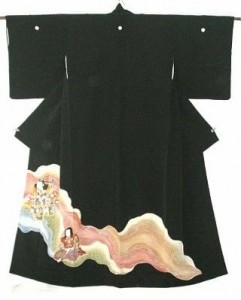 | Kurotomesode
Similar to irotomesode, but black. These are the most formal kimono for married women. They are worn by the mothers of the bride and groom at weddings, black-tie events, children’s graduation, etc. They are appropriate for anything celebratory or ceremonial. They show up on the secondary market quite frequently, because in modern times they are one of the most often-used kimono, as women tend to only wear them now for “big” events. Appropriate obi are fukuro or maru with celebratory motifs, usually with plenty of gold. |
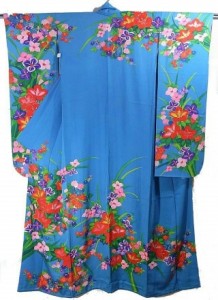 | Kakeshita, also Hanayome
These are unique wedding kimono. They are meant to be worn trailing (see hikizuri, below) by a bride at her wedding. The overall wedding ensemble is very specialized and complicated, with many significant accessories and a specific dressing style. There are licensed salons and studios in Japan that deal solely in dressing brides for their weddings. The designs are typically very vibrant and colourful, and often have lots of flowers and cranes or other celebratory motifs. They will also generally have a lot of gold foil or couching (outline embroidery). |
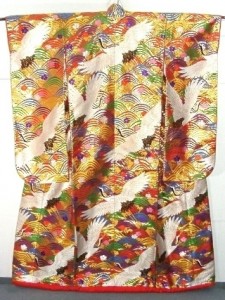 | Uchikake
Uchikake are not what people generally think of as a kimono, they are not worn over an underrobe and tied shut with an obi. They are part of a traditional bridal ensembled, and worn trailing over the rest of the ensemble, including the kakeshita and the obi. They are more like very elaborate over-robes, and although historically they were common for the upper class and nobility, they not something that are worn in modern day in any other circumstances (aside from theatre performance). However, they do look stunning when hung on a rod as a decorative accent in the right decor. |
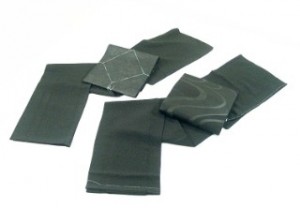 | Mofuku
Mofuku is mourning wear. This is a kimono (and obi) of solid black, worn by the family of the deceased at a funeral. A mofuku kimono will be solid black with a white lining and five white crests. These often turn up on the secondary market, but I personally believe it to be in incredibly bad taste to buy one of these and wear it for any other circumstance. These kimono were worn by people mourning the loss of someone very close to them, and the associations to the Japanese can be very negative. It’s becoming more common to see mofuku accessories (obiage, obijime) being worn with regular outfits, but the kimono itself is one of the items that I don’t think will ever escape the negative stigma. Mofuku kimono are always worn with solid black nagoya obi, black obiage and obijime, white haneri, white tabi, and black zori. |
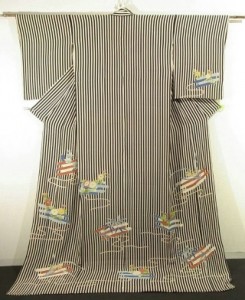 | Hikizuri, also Susohiki
Hikizuri and susohiki actually refer to the way that the kimono is worn, it means basically “trailing skirt”. These kimono are worn by geisha, dancers, and other traditional stage performers. They can be nearly any of the styles listed above – komon, irotomesode, kurotomesode, etc. Maiko (apprentice geisha) wear furisode hikuzuri. Kakeshita, the wedding kimono mentioned above, are also technically hikizuri, and this is probably the only time an average woman will wear a kimono of this style. They are best purchased for collecting purposes or cosplay, not for wearing out to events. |














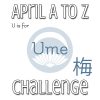
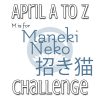
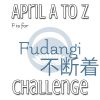












 Bebe Taian
Bebe Taian CHOKO Blog
CHOKO Blog Gion Kobu
Gion Kobu
Pingback: J-Culture: Kimono – onlysakura
Thank you for posting that video of the stitching. It will make sewing my collars so much easier now!
Elizabeth recently posted..Panels for 2011
No problem. It’s such a great and efficient way to do it, and I’m very grateful to Naomi for showing it to me, so I figured it needed to be shared.